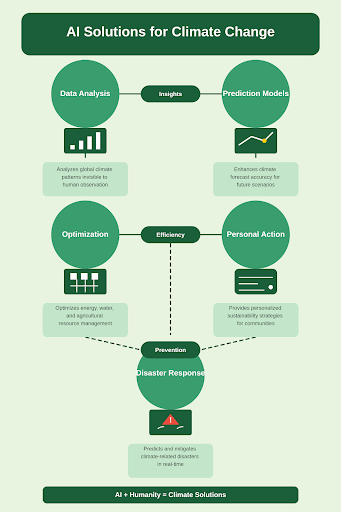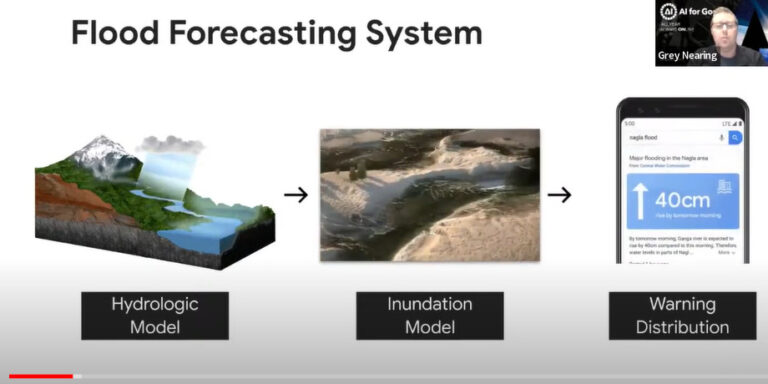The world is approaching a watershed moment. Climate change could wreak havoc on our planet if we do not reduce greenhouse gas emissions by 2030. This can surely affect all aspects of society, from food production to the economy and health. How can we mitigate these impacts and move toward a more sustainable future?
The scale and urgency of this challenge demand an innovative solution to overcome it. One of the promising solutions in technology is AI in climate change. This transformative technology can potentially revolutionize our approach to climate change. AI works on data (a vast amount), analyzes it, and predicts the outcomes, unlike any other process.
This way, artificial intelligence and data science offer various unprecedented opportunities to tackle the climate crisis. However, its adoption is not without challenges and requires a comprehensive approach to address them.
Understanding AI For Climate Change
Artificial Intelligence helps solve critical problems, recognize patterns, and identify trends, leading to improved decision-making. It achieves this through machine learning algorithms and AI models that quickly process vast amounts of data, allowing for better predictions.
How Helpful Is AI for Climate Change?
Artificial Intelligence is powered by data and improved by training. It can help with a wide range of tasks, including tackling climate change. Here is a brief understanding of AI’s impact on climate change.
- AI technology can check on vast climate data to find patterns and make predictions quickly.
- The data-driven analysis can lead to more accurate future predictions related to climate scenarios, helping us prepare better.
- AI benefits climate change efforts through improved data analysis and resource management. AI chatbot development is crucial for educating the public, providing personalized sustainability tips, fostering community engagement, and facilitating access to climate resources.
- AI can help predict and manage climate-related disasters like floods and wildfires.

Ways AI Technology Helps Combat Climate Change
AI technology is increasingly being used to fight climate-related changes by providing innovative AI-based solutions across diverse industries. Below are some ways in which this technology is helping to combat the climate crisis.
AI-driven Waste Management
Waste contributes significantly to climate change through greenhouse gas emissions during its creation, transportation, and disposal. AI solutions have revolutionized waste management by improving recycling, reducing waste, and optimizing waste collection routes. With high-precision AI solutions in environmental science, recyclable materials can be identified, enabling efficient recycling.
Real-life example: AMP Robotics is using AI to automate recycling sorting, making it more efficient and improving recycling rates.
Source: AI for recycling – AMP Robotics
AI in Renewable Energy
We are in the 21st century, and AI is one of the most talked-about innovations powering every industry. This technology optimizes renewable energy generation, distribution, and consumption. AI helps integrate renewable sources like solar and wind power into the energy grid more efficiently by predicting energy demand and optimizing grid operations.
Real-life AI-based solution: GraphCast, an AI-powered weather forecasting model by Google DeepMind, uses graph neural networks to produce faster and more accurate forecasts, improving renewable energy efficiency.
Source: Deepmind
AI-Powered Climate Predictions
Artificial Intelligence can analyze vast historical data to predict future climate conditions. They can forecast temperature changes, weather patterns, and ocean levels, which are crucial for mitigating climate change and making informed decisions.
Real-life Example: IBM’s Green Horizons initiative uses AI and machine learning to improve climate forecasting. This AI system predicts future air quality by analyzing satellite data, weather stations, and sensor networks.
AI Helps Predict Climatic Disasters
Artificial intelligence can detect early signs of environmental disasters like hurricanes, floods, or wildfires. This can save valuable time for a city or country preparing for the event. Early warning can save lives, reduce damage, and help authorities coordinate response efforts.
Example: Google’s AI-powered Flood Early Warning System provides timely alerts to at-risk communities, enabling them to take necessary precautions.

Source: Google’s Flood Forecasting System
AI for Environmental Monitoring
AI systems are helping monitor environmental variables such as air quality, water pollution, and deforestation. These systems collect data from sensors and satellites, analyze trends, and assist policymakers in making more informed decisions.
Example: Companies like Planet use AI and machine learning to analyze satellite imagery and track deforestation, illegal logging, and other environmental changes, enabling timely interventions.
AI in Energy Efficiency
AI-driven technologies can optimize the energy consumption of buildings, industries, and homes by analyzing energy usage patterns and suggesting improvements. AI integration helps reduce waste and ensures that energy is used more efficiently.
Examples: CarbonCure leverages AI to cut CO₂ emissions by optimizing material usage in concrete production. Also, Google’s DeepMind reduced energy use in its data centers by 40% by optimizing cooling systems with AI.
How Effective is AI in Climate Change Adaptation?
AI is a powerful technology in the fight against climate change, offering solutions across various domains. Its ability to analyze massive datasets, identify patterns, and optimize complex systems makes it invaluable for understanding climate dynamics, predicting impacts, and developing mitigation strategies.
Advanced Climate Modeling and Forecasting
The role played by AI in digital transformation can also help enhance our understanding of climate change by improving the accuracy and resolution of climate models.
- AI algorithms can analyze vast amounts of climate data, from historical weather patterns to social media, to improve decision-making.
- AI transition monitoring in climate change uses AI to track progress on climate action and enables real-time emissions and energy use monitoring.
- AI models provide accurate, localized climate trends and extreme weather forecasts, improving preparedness and adaptation.
Enhanced Disaster Preparedness and Response
AI-powered systems improve our ability to prepare for and respond to climate-related disasters.
- AI algorithms analyze real-time weather data to predict extreme weather events, offering timely alerts for proactive evacuation and preparation.
- AI analyzes satellite imagery to assess disaster damage quickly, aiding in prioritizing rescue efforts and resource allocation.
- AI-based solutions optimize the deployment of emergency responders and resources for quick and efficient assistance.
Protect Biodiversity and Ecosystem
AI plays a crucial role in monitoring and conserving biodiversity in the face of climate change.
- AI can track and monitor endangered species using image and sound recognition.
- Using satellite imagery to find these activities can help stop illegal logging and deforestation.
- AI can help stop the illegal wildlife trade by analyzing online and shipping data.
Sustainable Resource Management
AI technology contributes to more sustainable resource management, mitigating the impacts of climate change.
- AI systems optimize agriculture irrigation, fertilization, and pest control, reducing waste and improving crop yields with minimal environmental impact.
- This modern-day technology optimizes energy distribution in smart grids, enhancing efficiency and reducing fossil fuel reliance.
- AI analyzes sensor data and weather forecasts to optimize water allocation, ensuring efficient use in drought-prone areas.
Types of AI Models Help in Climate Change
AI models are pivotal in combating climate change by helping predict, mitigate, and adapt to its impacts. Various models analyze vast amounts of environmental data, optimize energy use, and forecast future climate patterns. Below are the key types of models that help tackle AI for climate change.
1. Machine Learning Models
ML is a subset of AI that uses algorithms to analyze patterns in data and make predictions or decisions without being explicitly programmed. Here’s how it helps:
- It is widely used in climate change applications because it can process large datasets to uncover trends and make accurate predictions.
- It can optimize energy use in buildings and industries by analyzing usage and making recommendations.
Real-life example:
Google’s AI-powered environmental monitoring tool uses ML to help track the health of forests and ecosystems in real time.
2. Deep Learning Models
Deep learning utilizes deep (multi-layered) artificial neural networks to uncover intricate patterns in a massive data set. It excels at image recognition, speech processing, and natural language understanding. It can be used to:
- This AI model helps predict natural disasters based on complex patterns in weather data.
- Deep learning models can forecast renewable energy production based on real-time weather data.
3. Generative Adversarial Networks (GANs)
GANs are generative artificial intelligence model types consisting of two neural networks: a generator and a discriminator. These work together where the generator creates synthetic data, and the discriminator evaluates its credibility. The two networks compete against each other, and through this process, GANs can produce highly realistic data. This model can help in mitigating climate change by:
- GANs can generate synthetic climate data to improve regional climate models and future climate predictions in data-scarce areas.
- These models can design sustainable cities with green spaces, energy-efficient buildings, and efficient transportation.
Real-life Example:
AI for Earth by Microsoft simulates climate change scenarios and produces realistic synthetic data, such as modeling potential climate impacts on agriculture, water resources, and ecosystems.
Challenges of Adopting AI for Climate Change Solutions
AI can potentially revolutionize how we address climate change. From optimizing energy use and predicting weather patterns to developing sustainable solutions, AI can provide innovative tools to mitigate environmental impacts. However, adopting AI in climate change solutions presents several challenges that must be addressed to fully harness its potential.
Data Availability and Quality
AI models rely heavily on high-quality and relevant data. Acquiring accurate and comprehensive datasets (environmental, meteorological, and geographical) can be challenging in the context of climate change. Often, data is inconsistent, fragmented, or unavailable, making it difficult to deliver precise predictions.
Data Privacy and Security
Data privacy and security are crucial when using AI to address climate change, as climate data is sensitive. Data breaches and cyber threats raise concerns about trust and compliance with regulations.
Computational Resources
Training AI models requires significant computational power. Complex climate modeling and simulations require processing vast amounts of data, often on supercomputers or cloud systems. This can be costly and may require specialized infrastructure.
Algorithm Bias
The data used to train AI models can contain biases, which these models can perpetuate. For example, if climate data reflects historical inequalities, an AI system may unintentionally prioritize the needs of specific communities or geographical regions over others. This can exacerbate environmental injustices, as marginalized populations bear a disproportionate share of the climate crisis.
Lack of Skilled AI professionals
Skill is sometimes a deficit, even though we have everything precisely available. In climate science, there is a shortage of specialized experts. Building AI systems to solve complex environmental challenges requires interdisciplinary knowledge. Hence, it is wise to seek artificial intelligence consulting to get a detailed roadmap before investing your budget. Though it can be typical, proper research can aid you in this.
How to Overcome These Challenges?
Every problem has a solution if time, research, and effort are invested strategically. These challenges related to artificial intelligence integration in solutions can be addressed if:
Investing in Data Infrastructure and Training
A robust data collection system should be developed. Plus, investing in high-quality, comprehensive climate datasets will be valuable in training AI models. This way, AI-first solutions will deliver accurate predictions, improving their effectiveness and reliability.
High-performance Computing
Once done, look for modern computational power, such as cloud computing or supercomputers, to perform large-scale processing. This will reduce environmental impact by ensuring energy-efficient systems.
Developing Ethical Guidelines and AI Regulations
Establish ethical frameworks and regulations prioritizing fairness, transparency, and accountability in the type of AI model development you seek. This will help prevent bias and ensure equitable outcomes in climate-related AI applications.
Work With a Skilled Team
Lastly, you can seek experienced and top-tier expertise. It is wise to look for skilled AI development companies, perform proper research, and check their experience related to climate change solution development. Look for all other factors to help you find the right AI-first experts.
How Potential is AI in Climate Change?
Climate change is one of the most pressing challenges of our time, requiring innovative and scalable solutions. Artificial Intelligence in climate change has already demonstrated its potential to address issues, from optimizing energy use to predicting natural disasters. However, the true power of AI lies in its future advancements and its ability to integrate with other advanced technologies.
Advancements in AI technology
Future advancements in AI related to environmental sustainability are poised to revolutionize climate change mitigation efforts. Here are some key areas where AI could make a transformative impact:
AI in Bioengineering
This technology can accelerate the development of carbon-capturing organisms or bioengineered plants that absorb more CO₂. For example, researchers are using AI to design microbes that convert greenhouse gases into valuable products like biofuels.
AI for Carbon Capture and Storage
AI technology can optimize the design and operation of carbon capture systems, making them more efficient and cost-effective. For instance, AI can identify the best locations for CCS facilities and predict their long-term performance.
AI for Circular Economies
Artificial Intelligence can enable more intelligent resource management by tracking material flows and optimizing recycling processes, reducing waste and emissions.
AI Climate Resilient Infrastructure
AI can help design infrastructure that adapts to climate change, such as flood-resistant buildings or heat-tolerant transportation systems.
Collaboration between AI and other technologies
AI’s integration with technologies like blockchain and the Internet of Things (IoT) will allow for smarter, more efficient solutions. AI-powered blockchain solutions can ensure transparent, decentralized carbon tracking. At the same time, IoT devices can collect real-time environmental data, enabling AI systems to optimize energy consumption, waste management, and resource allocation.
AI as a game-changer
When combined with human innovation and policy action, it has the potential to be the breakthrough needed to solve the climate crisis. Here’s why:
- This technology can process and analyze data at scale and provide precise and scalable solutions.
- AI technology helps accelerate the deployment of climate solutions, from renewable energy optimization to disaster response.
- One can get comprehensive insights to make accurate and working strategies with expert-backed AI integration in climate solutions.
Conclusion
Artificial Intelligence is proving to be a transformative force in combating climate change. This technology helps optimize renewable energy, predict disasters, and help protect and manage resources optimally. Though AI in environmental science can help a lot, challenges still need to be addressed effectively. However, AI is still a technology, and it alone is not enough. Human innovation and policy action should collaborate accurately with AI to leverage its full potential.

Partner with Experts
Frequently Asked Questions
Are there any challenges associated with AI for climate change usage?







Yes, there are specific challenges associated with leveraging the complete potential of AI. Here are some:
- Data quality and availability
- Computational resources
- Algorithm bias
- Lack of skilled AI experts
Can Generative AI help mitigate climate change?












Can AI improve renewable energy production?












How can AI help tackle climate change?












What does AI predict about climate change?















